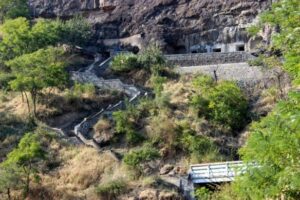
Aurangabad is located in a valley watered by the river Dudhna between the Sihyachal and Satara range of hills. The ancient name of Aurangabad is Khirki which means a ‘window’ or ‘entrance’.
The Aurangabad caves are located on a hill running roughly east to west, nearly 2 km behind Bibi-ka-Maqbara in Aurangabad Maharashtra. Twelve Buddhist Caves are found here which fall into three separate groups depending on its location. The first group consists of caves 1 to 5, the second 6 to 9 and third 10 to 12. The caves are datable from circa 2nd – 3rd century AD to 7th century AD. The first and the second groups are separated by nearly 500 metres from each other, with the former at the western side while the latter is on the eastern side of the same hill. The third group is further east of the second group.
At Aurangabad, due to its proximity to the ancient trade route and close to Pratishthana (modern Paithan), the capital of Satavahanas, patronage to religious activities can be understood, even though this is not corroborated by inscriptional evidences. Here the earliest excavations (Caves 1 & 3) probably date to 2nd – 3rd century A.D. Cave 3 is in the form of a chaitya griha of the Hinayana order, albeit preserved very badly due to the nature of the rock formation. The heterogeneous rock formation here has prevented very large scale excavations. The excavators have taken much care to avoid portions where the lose rock formations were present. Cave 1 is an unfinished vihara, the ceiling of verandah has fallen down. Cave 2 is also a vihara with a shrine of Buddha at the rear.
The remaining caves are generally ascribed to the Kalachuri dynasty. Of all, Cave 7 is the most elaborate and famous for its sculptural embellishments. On plan it includes a central shrine with circumambulation with an outer corridor running all around. This corridor has recesses at regular intervals which are carved with various Buddhist gods and goddesses.
The front wall of the verandah has very beautiful representation of a panel of litany of Avalokitesvara and Bodhisatva on either side the entrance to the shrine. The litany of Avalokitesvara is particularly more elaborate from similar examples at Ajanta and Ellora. The litany of Avalokitesvara represents the Bodhisatva Padmapani as ‘Saviour of Eight Great Perils’ (Fire, Theft, Demon, Elephant, Lion, Shipwreck, Snake, and Monkey).
The other important sculptural panels are of Tara, the principal consort of Avalokitesvara, depicted to the left of central shrine door and a group of six female musicians on the left wall of the main shrine. The latter is particularly very famous and often taken as the representative sculptural panel of the Aurangabad Caves. The main figure at the center is in a dancing attitude, with the five others playing different musical instruments.
The remaining caves of the second group are of less important due to incomplete excavations.
Source:
http://asi.nic.in/asi_monu_whs_ellora_aurangabad.asp
https://thatandthisinmumbai.wordpress.com/2014/12/07/travel-aurangabad-rock-cut-caves
http://www.indiamonuments.org/Maharashtra/Maharashtra%2009/Maharashtra%2009.htm


